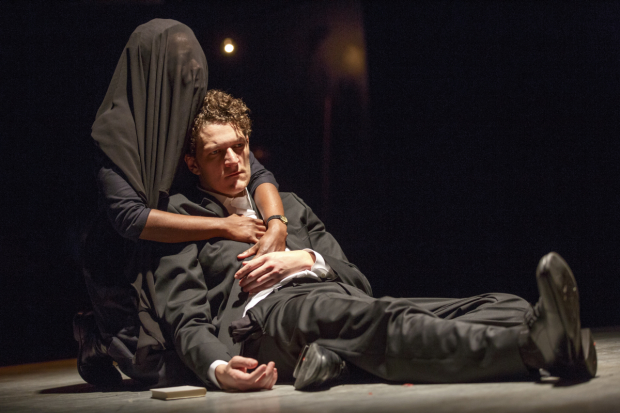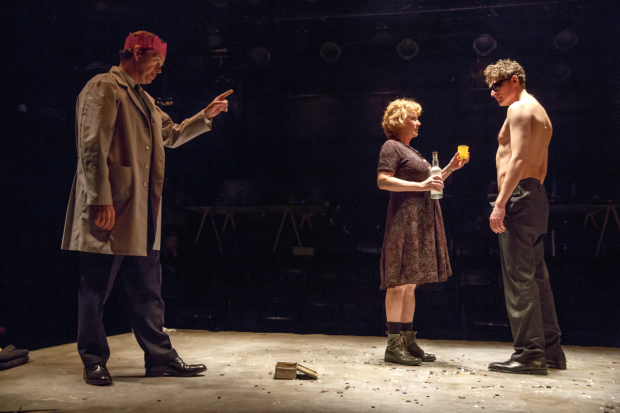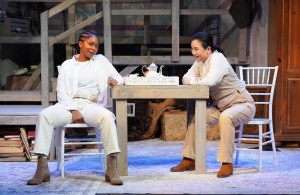
(© Joan Marcus)
A man peels an onion live onstage in John Doyle's adaptation of Henrik Ibsen's Peer Gynt, now at Classic Stage Company. His eyes water as he digs into the layered vegetable, searching in vain for a core. Would you believe that this is the most dramatically compelling moment of the whole play? Unlike most of the other scenes, the stakes feel real and palpable — and may even bring tears to our eyes. Unfortunately, the remainder of this cleverly conceived but confusingly executed production is as sleepy as it is opaque.
In fairness, Peer Gynt is notoriously difficult to stage. Written in 1876 (before Ibsen penned major domestic dramas like A Doll's House and Hedda Gabler), it's an expansive five-act verse play that follows the rascally Peer Gynt (Gabriel Ebert) from the home of his mother (Becky Ann Baker) to the hall of the Troll King (Dylan Baker) to the coast of North Africa and a lunatic asylum. Fortunes are made and lost as hearts are broken. All the while, Peer's authentic self eludes him, a problem that becomes increasingly urgent as his eventual fate at the hands of the Button Molder (a delightfully blue collar Adam Heller) draws near: In this world, the mediocre are melted down into buttons. This sprawling adventure fantasy is almost always truncated in production. Even Ibsen allegedly remarked, "I don't think the play's for acting."
Of course, scholars say the same thing about Lessing's Nathan the Wise, but Classic Stage proved them wrong in their very watchable mounting. Sadly, the magic doesn't extend to Peer Gynt, which is about as morose as its conceit.

(© Joan Marcus)
Doyle's production seems to take place at a funeral: Costume designer Ann Hould-Ward outfits everyone in conservative black garb. Church bells toll in the distance (evocative sound design by Dan Moses Schreier) as the actors sullenly march into the center of the room (Doyle stages in the round on David L. Arsenault's weathered platform of a set). The concept makes sense: Funerals are the one event in which we attempt to encapsulate the full scope of a person's life (but usually just succeed in reducing it to a comforting myth for the living). Essentially, we mourners are the button molders, melting down the dead into a boring yet functional mold. In bringing such relatable logic to his staging, however, Doyle has reduced a messy and fantastical tale into one that is merely dull.
It doesn't help that elements of the direction and design thwart basic storytelling: At the top of the show, Becky Ann Baker scatters hundreds of buttons across the stage. As the actors perform, the little plastic pieces become stuck to their shoes or are kicked off into the wings to be lost and forgotten. Is this a compelling visual metaphor for disposable human souls in an industrial economy? Perhaps, but it's also a distracting one, especially when we're struggling to pay attention to the disjointed dialogue of this translation.

(© Joan Marcus)
Leading the cast, Ebert's Peer is an overgrown man-child, an appropriate choice for the famously imaginative Norwegian. Still, some of his solo scenes verge on the schizophrenic in a way that is more confusing than illuminating. As Peer's mom, Becky Ann Baker seems to be channeling Sally Field in Forrest Gump, delivering all of her lines with a down-home southern accent. Meanwhile, Quincy Tyler Bernstine is underutilized as Solveig, the long-suffering woman who waits for Peer until death. She spends much of her stage time wearing a veil and babbling about Pentecost. For an ensemble of such talented actors, no one seems to be on the same page.
By the end, the stakes are just too low and the execution too vague for us to wish for a happy, or even a bittersweet, ending.











